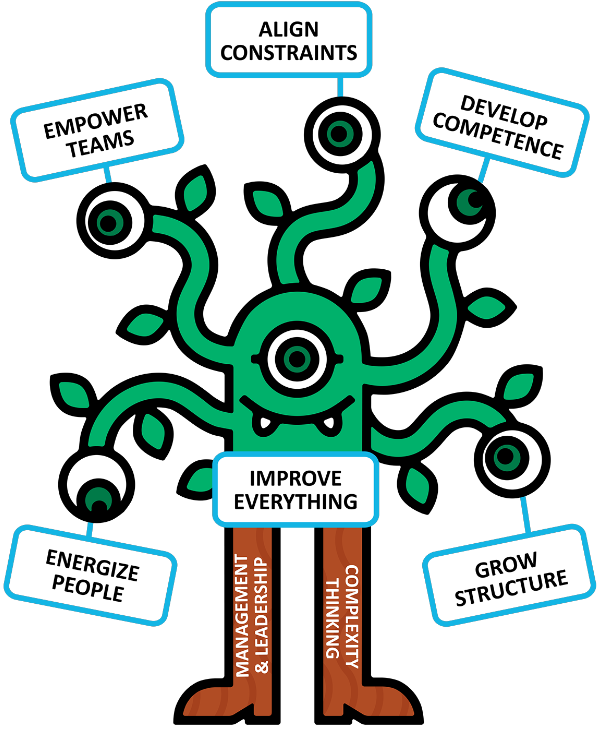by Management 3.0 Facilitator Jürgen Mohr
Management 3.0 stands for modern, agile management and leadership. Teal organizations reflect society and the prospective view of the world by the individual people constituting the society. It’s said that both models will play an ever-increasing role when talking about future organizations.
But what is meant with Teal Organizations and how are they related to Management 3.0?
Organizational Classification
In his book, Reinventing Organizations, Frederic Laloux first introduced the Evolutionary-Teal Organization, or short Teal Organization. Laloux distinguishes different types of organizations with individual specific characteristics: Red, Amber, Orange, Green, and Teal.
With each shift of society to another worldview a radically new type of organization was created. Be aware that this is not a maturity model for organizations and in no time only one organizational type exists. There was, is and will always be a mixture of them. The mixture reflects the current society, with the dominant organizational type reflecting the dominant societal power structure.
Management 3.0 classifies organizations into Management 1.0, Management 2.0, and Management 3.0. It’s a view on management that comprises the whole organization, not only managers and leaders. It considers the structures, people, and processes.
Let’s compare Fredric Laloux’s organizational types with the Management 3.0 organizational types:
Red – The guiding metaphor is Wolf Pack
Red had its time before the Middle Ages, when power and fear were the key to rule, as it still is within organizations like the Mafia or street gangs today. Those organizations are characterized through constant exercise of power by the chief over his troops. The organization is controlled by fear.
There is no equivalent in Management 3.0.
Amber – The guiding metaphor is Army
Red is followed by Amber with the catholic church as the dominant factor in society, but also reflected in military, most government agencies and public school systems. Top-down command-and-control systems with formal roles and stable processes are predominant. The future is a repetition of the past.
There is no equivalent in Management 3.0.

Orange – The guiding metaphor is Machine
Orange views the organization like a machine and had its maximum at the peak of the industrial revolution. It is visible in most multinational companies today. The focus is on profit and growth, innovation is there to beat the competition. Managed through command-and-control on what to do using Management by objectives.
Management 1.0 also views an organization like a machine. In this style of management, leaders assume that improvement of the whole requires monitoring, repairing, and replacing the parts, where employees are also considered parts of the machine.
Green – The guiding metaphor is Family
Orange is currently getting substituted by Green, where organizations are seen more like a family and can be found in culture-driven organizations. The focus is on culture and empowerment to achieve extraordinary employee motivation but within the classic pyramid structure.
This is equivalent to a Management 2.0 organization, where everyone recognizes that “people are the most valuable assets” and that managers have to become “servant leaders”. But, at the same time, organizations stick to the hierarchy. In those organizations culture becomes a very important factor.
Teal – The guiding metaphor is Living System
These are purpose-driven organizations, in which the purpose evolutionary evolves. Employees don’t put a mask on when going to work. Self-management is how the organization is controlled, with no need for hierarchy or consensus.
Management 3.0 also views an organization as a living system, best described with the metaphor of a community or a city. In a community or city, everyone is (partly) responsible for contributing to its success and a few are responsible for the whole. You can do what you want, as long as you allow the community to benefit from your work.
Let’s look a little deeper into the characteristics of Teal Organizations before going into more detail comparing both models:
Teal Organization Characteristics
According to Laloux, Teal Organizations will be the dominant ones in the future based on a fundamental change in our society. People strive for self-fulfillment and not for money anymore. Money, formerly seen as the primary goal of living, is becoming a by-product, necessary to live but not the goal in life itself. Living a happy and fulfilled life, knowing one’s values and aligning one’s life according to them becomes the most important aspect. This mindset is reflected in Teal Organizations which are characterized through three breakthroughs.
Self-Management
Teal organizations work efficiently without the need for hierarchy and consensus, even on a large scale. The system is based on peer relationships. Leadership, still existent, evolves systematically through people striving for a goal that is shared by followers. Leadership by Example, something we explicitly teach to managers these days, will be naturally within Teal organizations.
Wholeness
Remember the last time you went to work. The moment you enter the building or your work environment, you put on your job mask. You are not the person you are in your private life. This is a leftover of the industrial revolution where people were explicitly prompted to leave their private life at the door when entering the factory. In Teal organizations people don’t put on a mask when entering work. They bring their whole personality to work.
Evolutionary Purpose
In Teal Organizations profit maximization is not the goal. Money is not the end, it’s a means to an end. It’s a necessity to run the business, but not the goal. Teal organizations strive for a higher purpose. This purpose may evolve over time, reflecting that you cannot predict and control the future, instead you need to explore it. Everyone is invited to experience the sense of the organization.
Structures, Practices, and Processes
It seems that Management 3.0 and Teal Organizations share a very similar categorization of organizations. Let’s look a little deeper into both models. Management 3.0 defines six views of management:

Let’s have a brief look if and how they are reflected in Teal Organizations.
Management 3.0 View #1: Energize People
It’s about keeping people active, creative, engaged, and motivated. Why is employee motivation important? How do we motivate employees? How can we increase employee engagement? What are the key drivers of motivation and engagement?
Reflected in Teal Organizations through:
- Office Spaces: Self-decorated, warm spaces, open to children, animals, and nature
- Reflective Spaces: Quiet room; group meditation and silence practices; large group reflection practices; team supervision and peer coaching.
- Individual Purpose: Recruitment, training, and appraisals used to explore juncture of individual calling and organizational purpose.
- Flexibility: High degree of flexibility in working hours, as long as commitments are upheld.
Management 3.0 View #2: Empower Teams
Teams can self-organize, and this requires empowerment, authorization, and trust. Delegation increases status, power and control. A system with distributed control has a better chance of survival than a system with centralized control.
Reflected in Teal Organizations:
- Staff Functions: Most functions are performed by teams themselves.
- Decision-making: Fully decentralized based on advice.
- Strategy: Strategy emerges organically from the collective intelligence of self-managing employees.
Management 3.0 View #3: Align Constraints
Self-organization can lead to anything, and it’s therefore necessary to give people a clear purpose and defined goals. Clarity of values can make a significant contribution toward good behaviors and a better culture.
Reflected in Teal Organizations:
- Information Flow: All information available in real-time, including about company financials and compensation.
- Values: Clear values translated into explicit ground rules of (un)acceptable behaviors.
- Mood Management: Conscious sensing of what mood would serve the organization’s purpose.
- Purpose: Organizations seen as a living entity with its own evolutionary purpose, the concept of competition is irrelevant.
Management 3.0 View #4: Develop Competence
Teams cannot achieve their goals if members aren’t capable. But what makes a team competent is not only individual competence. We have to also consider team communication, and helping each other.
Reflected in Teal Organizations through:
- Onboarding: Significant training in relational skills and in company culture; rotation programs to immerse oneself in the organization.
- Training: Personal freedom and responsibility for training; critical importance of common training that everybody attends.
- Performance Management: Focus on team performance; peer-based processes for individual appraisals.
Management 3.0 View #5: Grow Structure
Many teams operate within the context of a complex organization, and thus it is important to consider structures that enhance communication. Common patterns such as Value Units, Small Teams, Replace Job Titles, Communities of Practice, and Open Allocation help balancing organizational structures.
- Reflected in Teal Organizations through:
- Organization Structure: Self-organizing teams; when needed, coaches cover several teams.
- Coordination: No executive team meetings; coordination and meetings mostly ad hoc when needs arise.
- Job Titles: No job titles; fluid and granular roles instead.
Management 3.0 View #6: Improve Everything
It’s not about the first-mover advantage anymore, it’s about the fastest-learner advantage. People, teams, and organizations need to improve continuously.
Reflected in Teal Organizations through:
- Innovation & Product Development: Inside out: offer is defined by purpose; guided by intuition and beauty.
- Change Management: “Change” no longer a relevant topic because organizations constantly adapt from within.
To be honest, there is often not a one-to-one mapping of the Teal characteristics to the six views of Management 3.0. But both models seem to be alike.
Management 3.0 and Teal Organizations have a lot in common
Both postulate that future organizations will look much different from what we see today and that those organizations make use of the Management 3.0 mindset and Teal characteristics. Both models share a very similar categorization of organizations and each category has a specific characteristic. Even if the details are described differently in both models, the six views in Management 3.0 and the structures, practices, and processes in Teal Organizations share the same mindset.
But there’s one major difference between the two models:
Management 3.0 looks at the organization from an internal perspective centering around the task of Management and claims that managers are still necessary.
Teal views the organization from a societal perspective, where the organization reflects the characteristics of the society and the normative understanding of the world by the individual people constituting this society. Teal also doesn’t demand formal managers.
Want to learn more about Management 3.0?
Attend a Workshop near you:

